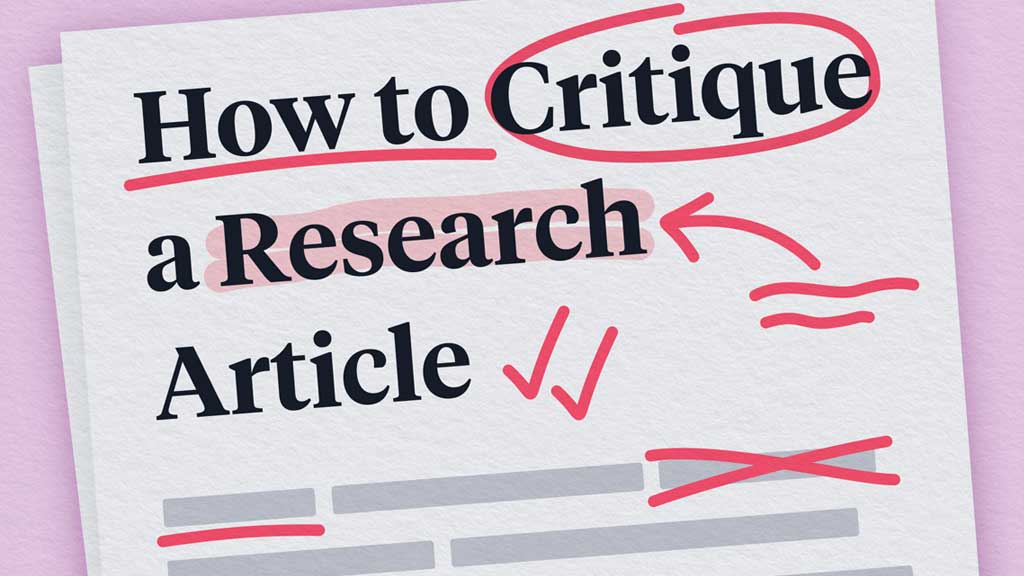Let's briefly examine some basic pointers on how to perform a literature review.
If you've managed to get your hands on peer-reviewed articles, then you may wonder why it is necessary for you to perform your own article critique. Surely the article will be of good quality if it has made it through the peer-review process?
Unfortunately, this is not always the case.
Publication bias can occur when editors only accept manuscripts that have a bearing on the direction of their own research, or reject manuscripts with negative findings. Additionally, not all peer reviewers have expert knowledge on certain subject matters, which can introduce bias and sometimes a conflict of interest.
Performing your own critical analysis of an article allows you to consider its value to you and to your workplace.
Critical evaluation is defined as a systematic way of considering the truthfulness of a piece of research, its results and how relevant and applicable they are.
How to Critique
It can be a little overwhelming trying to critique an article when you're not sure where to start. Considering the article under the following headings may be of some use:
Title of Study/Research
You may be a better judge of this after reading the article, but the title should succinctly reflect the content of the work, stimulating readers' interest.
Keywords
Three to six keywords that encapsulate the main topics of the research will have been drawn from the body of the article.
Introduction
This should include:
- Evidence of a literature review that is relevant and recent, critically appraising other works rather than merely describing them
- Background information on the study to orientate the reader to the problem
- Hypothesis or aims of the study
- Rationale for the study that justifies its need, i.e. to explore an un-investigated gap in the literature.

Materials and Methods
Similar to a recipe, the description of materials and methods will allow others to replicate the study elsewhere if needed. It should both contain and justify the exact specifications of selection criteria, sample size, response rate and any statistics used. This will demonstrate how the study is capable of achieving its aims. Things to consider in this section are:
- What sort of sampling technique and size was used?
- What proportion of the eligible sample participated? (e.g. '553 responded to a survey sent to 750 medical technologists'
- Were all eligible groups sampled? (e.g. was the survey sent only in English?)
- What were the strengths and weaknesses of the study?
- Were there threats to the reliability and validity of the study, and were these controlled for?
- Were there any obvious biases?
- If a trial was undertaken, was it randomised, case-controlled, blinded or double-blinded?
Results
Results should be statistically analysed and presented in a way that an average reader of the journal will understand. Graphs and tables should be clear and promote clarity of the text. Consider whether:
- There were any major omissions in the results, which could indicate bias
- Percentages have been used to disguise small sample sizes
- The data generated is consistent with the data collected.
Negative results are just as relevant as research that produces positive results (but, as mentioned previously, may be omitted in publication due to editorial bias).
Discussion
This should show insight into the meaning and significance of the research findings. It should not introduce any new material but should address how the aims of the study have been met. The discussion should use previous research work and theoretical concepts as the context in which the new study can be interpreted. Any limitations of the study, including bias, should be clearly presented. You will need to evaluate whether the author has clearly interpreted the results of the study, or whether the results could be interpreted another way.
Conclusions
These should be clearly stated and will only be valid if the study was reliable, valid and used a representative sample size. There may also be recommendations for further research.
References
These should be relevant to the study, be up-to-date, and should provide a comprehensive list of citations within the text.
Final Thoughts
Undertaking a critique of a research article may seem challenging at first, but will help you to evaluate whether the article has relevance to your own practice and workplace. Reading a single article can act as a springboard into researching the topic more widely, and aids in ensuring your nursing practice remains current and is supported by existing literature.
Topics
References
- Marshall, G 2005, ‘Critiquing a Research Article’, Radiography, vol. 11, no. 1, viewed 2 October 2023, https://www.radiographyonline.com/article/S1078-8174(04)00119-1/fulltext

